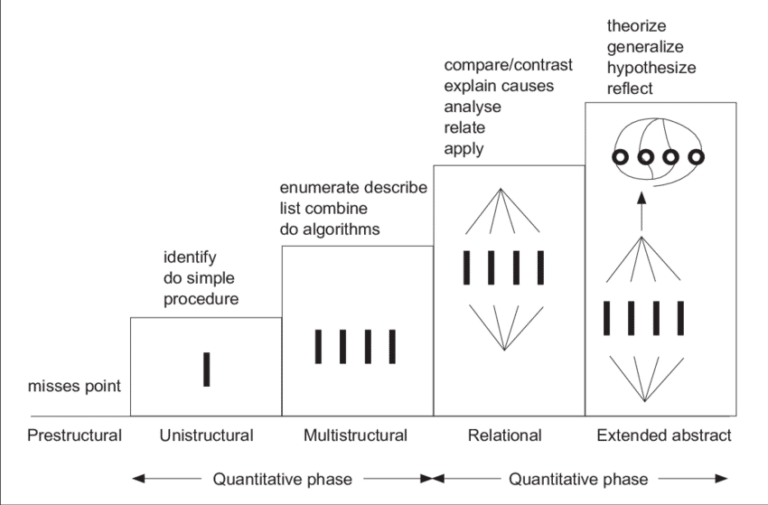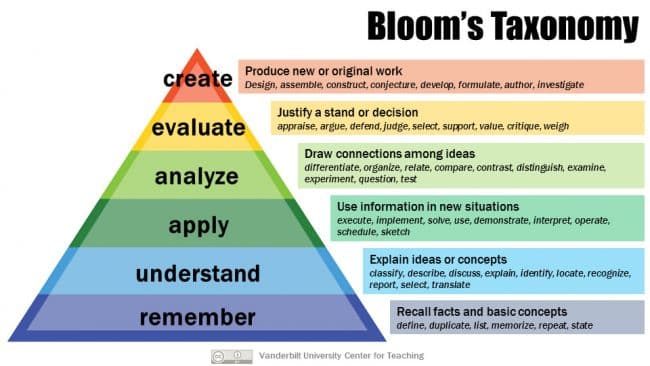Personal Development
Higher-Order Learning: Becoming An Expert

How do we become experts?
It will explore the characteristics and knowledge of an expert, how SOLO and Bloom’s revised taxonomy can assist us in identifying higher-order knowledge structures and thinking processes, as well as the challenges associated with higher-order thinking and how our program teaches it.
Expert Characteristics
Experts are individuals who possess a deep understanding of a subject, allowing them to solve complex problems and make informed decisions. In addition to having a large amount of knowledge, expertise also involves being able to apply that knowledge in novel and complex situations. In addition to thinking critically and solving problems, they are able to make informed decisions.
Expert knowledge is organized into structures that allow experts to think and reason more efficiently. These structures are often based on extensive experience in the field and are not readily accessible to novices. However, with the appropriate learning strategies, expert-level knowledge can be obtained much faster.
The definition of “expert knowledge”
SOLO (Structure of Observed Learning Outcomes) is a taxonomy for identifying expert higher-order knowledge structures. It describes a progression of levels of understanding, ranging from simple recall of information to the ability to think abstractly and make connections between ideas.
- Prestructural: A learner who does not understand the topic responds inappropriately or provides irrelevant information.
- Unistructural: The learner has a basic understanding of the topic and can identify one relevant aspect.
- Multistructural: Learner has a good understanding of the topic and can identify multiple relevant aspects.
- Relational: Learners demonstrate a deep understanding of how different aspects of a topic relate to one another by making connections between them.
- Extended Abstract: A high level of abstraction and creativity is demonstrated by the learner when they are able to generalize and transfer their understanding of the topic to new situations.

Experts have knowledge that is extended abstract. This is considered a higher-order knowledge structure.
Bloom’s revised taxonomy
This revised Bloom’s Taxonomy describes the progression of cognitive skills from simple recall of information to the ability to analyze, evaluate, and create higher-order knowledge structures.

If SOLO is a house, Bloom’s is the way we build the house. To build an expert-quality house, we must use expert-quality methods.
- Remembering: The learner is able to recall information from memory.
- Understanding: Learners are able to comprehend the meaning of the information.
- Applying: The learner can apply the information to solve a problem or complete a task.
- Learning to analyze: The learner can break complex information down into its component parts and identify relationships between them.
- Evaluating: The learner can evaluate the information or ideas by making judgments.
- Creating: the learner can combine information or ideas to create something new.
One common misconception about Bloom’s revised taxonomy is that one cannot engage in higher-order learning without first engaging in lower-order learning. Before moving on to more complex thinking processes like analysing, evaluating, and creating, learners must first memorize and understand basic information. This isn’t necessarily true, and in fact it can be counterproductive to begin with lower-order learning.
Compared to higher-order learning, lower-order learning causes information to be forgotten more quickly. When multiple things to be learned at a high volume are to be learned, lower-order learning is inefficient since learners need to re-learn information frequently, which takes extra effort and time.
Higher-order thinking challenges
There is often a high cognitive load associated with higher-order thinking that is difficult for learners to handle. In short, learners sabotage themselves because they interpret the effort and difficulty associated with effective learning as a sign that the methods are ineffective. This is the misinterpreted-effort hypothesis.
The mission of iCanStudy has been to overcome these challenges. Our program teaches metacognition, self-reflection, and the ability to adjust learning strategies toward cognitively optimal techniques in order to teach students effective self-regulated higher-order learning.
In conclusion
It is not a simple process to become a specialist. Truly mastering any subject necessitates having a well-grounded comprehension and the capability to utilize that information in intricate circumstances, while also organizing knowledge into patterns that facilitate swift thinking and logic. SOLO and Bloom’s upgraded taxonomy give systems for recognizing higher-level cognition compositions and deliberative processes. Though, learners could have trouble comprehending the cognitive capacity of higher-level thought processes, often reverting to inferior techniques. To overcome this shortfall, learners should be tutored how to elevate their metacognitive awareness and independent learning techniques.
References
Biggs, J. B., & Collis, K. F. (1982). Evaluating the Quality of Learning: The SOLO Taxonomy (Structure of the Observed Learning Outcome). Academic Press.
Kirk-Johnson, A., Galla, B. M., & Fraundorf, S. H. (2019). Perceiving effort as poor learning: The misinterpreted-effort hypothesis of how experienced effort and perceived learning relate to study strategy choice. Cognitive Psychology, 115, 101237. https://doi.org/10.1016/j.cogpsych.2019.101237
Krathwohl, D. R. (2002). A revision of Bloom’s taxonomy: An overview. Theory into practice, 41(4), 212-218.
Mislevy, R. J., & Haertel, G. D. (2006). Implications of cognitive psychology for educational measurement. In R. L. Brennan (Ed.), Educational Measurement (4th ed., pp. 207-260). American Council on Education/Praeger Series on Higher Education.
Pintrich, P. R. (2000). The role of goal orientation in self-regulated learning. In M. Boekaerts, P. R. Pintrich, & M. Zeidner (Eds.), Handbook of Self-Regulation (pp. 451-502). Academic Press.
Schunk, D. H., & Zimmerman, B. J. (Eds.). (2008). Motivation and Self-Regulated Learning: Theory, Research, and Applications. Routledge.

